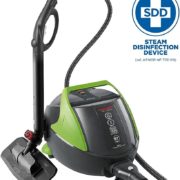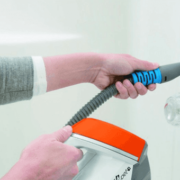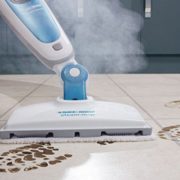Steam cleaning is a popular method used to deep clean carpets. However it is important to consider both the advantages and disadvantages before deciding if it is the right choice for you. In this post, you will learn about the pros and cons of steam cleaning carpets.
Let’s start with the pros. One of the major advantages of steam cleaning carpets is its ability to kill bacteria and germs that may be hiding deep within the fibres. Additionally, steam cleaning can effectively remove dirt, stains, and odours, leaving your carpets looking fresh and clean. Another benefit is that steam cleaning does not require the use of harsh chemicals, making it a safer option for both your family and the environment.
On the other hand, there are a few cons to consider as well. Steam cleaning can be time-consuming, especially if you have a large area of carpet to clean. It also requires some special equipment, such as a steam cleaner, which can be expensive to purchase or rent. Lastly, steam cleaning may not be suitable for all types of carpets, as some delicate fabrics can be damaged by the high temperatures and moisture involved in the process.
In conclusion, steam cleaning carpets has both its advantages and disadvantages. It is important to weigh the pros and cons before making a decision, taking into consideration factors such as your carpet type, budget, and time availability. Ultimately, the goal is to choose a carpet cleaning method that best suits your needs and keeps your carpets looking their best. Steam cleaning carpets is a popular and effective method of removing dirt, stains, and allergens from your carpets. This method uses hot water and steam to deep clean the fibers of your carpets, leaving them fresh and spotless. However, like any cleaning method, there are both pros and cons to consider before deciding if steam cleaning is the right choice for you. In this article, we will explore the benefits, drawbacks, cost considerations, equipment needed, and steps for steam cleaning carpets. We will also discuss the recommended frequency of steam cleaning, the difference between professional cleaning and DIY, and provide tips for successful steam cleaning. Additionally, we will explore alternative carpet cleaning methods to help you make an informed decision. So, let’s dive in and examine the pros and cons of steam cleaning carpets.
Benefits of Steam Cleaning Carpets
Deep and Effective Cleaning
One of the main benefits of steam cleaning carpets is its ability to provide a deep and thorough clean. The high temperature of the steam, along with the pressure generated by the steam cleaner, helps to loosen and remove dirt, stains, and grime from deep within the carpet fibres. This method is particularly effective at removing stubborn stains and odours that may have been embedded in the carpet for a long time, leaving your carpets looking fresh and revitalized.
Elimination of Allergens and Bacteria
Steam cleaning is also highly effective at eliminating allergens and bacteria that may be lurking in your carpets. The high temperature of the steam kills germs, fungi, and bacteria, while also neutralizing dust mites and other common allergens. This is especially beneficial for individuals with allergies or respiratory conditions, as it helps to create a cleaner and healthier indoor environment.
Environmentally Friendly
Another major advantage of steam cleaning carpets is that it is an environmentally friendly cleaning method. Unlike traditional carpet cleaning methods that rely on the use of harsh chemicals, steam cleaning uses only water and natural cleaning solutions. This means that steam cleaning is safer for both the environment and your health, as it reduces the exposure to harmful chemicals, while still delivering excellent cleaning results.
No Chemical Residue
Unlike other carpet cleaning methods that may leave behind a residue of cleaning chemicals, steam cleaning leaves no chemical residue behind. This is particularly important for households with children or pets, as it eliminates the risk of exposure to potentially harmful chemicals. Additionally, the absence of residues ensures that your carpets will stay cleaner for longer, as there is no sticky residue to attract dirt and debris.
Drawbacks of Steam Cleaning Carpets
Long Drying Time
One of the main drawbacks of steam cleaning carpets is the long drying time. Due to the use of hot water during the cleaning process, carpets tend to remain wet for a significant period of time after steam cleaning. This can be inconvenient, especially in high-traffic areas where immediate use of the carpet is desired. It is important to ensure proper ventilation and air circulation during the drying process to accelerate the drying time.
Potential Damage to Sensitive Fabrics
While steam cleaning is generally safe for most carpet types, there is a risk of potential damage to sensitive fabrics. Delicate materials, such as silk or wool, may not be suitable for steam cleaning and may require alternative cleaning methods. It is important to check the manufacturer’s guidelines and test a small inconspicuous area of the carpet before proceeding with steam cleaning to avoid any damage.
Not Suitable for All Carpet Types
In addition to sensitive fabrics, not all carpet types are suitable for steam cleaning. Certain types of carpets, such as jute or sisal, may be more prone to shrinking or warping when exposed to moisture. It is important to consider the specific type of carpet you have and consult with a professional cleaner if you are unsure whether steam cleaning is appropriate.
This image is property of images.unsplash.com.
Cost Considerations
Expensive Initial Investment
One of the cost considerations of steam cleaning carpets is the initial investment in equipment. Steam cleaner machines can be quite expensive, ranging from a few hundred to a few thousand dollars, depending on the brand and features. This initial cost may be a deterrent for some homeowners, especially if they have a small carpeted area or prefer to hire professional cleaners.
Possible Additional Costs
Along with the initial investment in a steam cleaner machine, there may be additional costs associated with steam cleaning carpets. These costs can include purchasing cleaning solutions or renting a professional-grade steam cleaner for larger or heavily soiled carpets. It is important to factor in these potential additional costs when considering the affordability of steam cleaning.
Equipment and Materials Needed
Steam Cleaner Machine
To steam clean your carpets, you will need a steam cleaner machine. There are various types and models available on the market, ranging from handheld steamers to larger, more powerful machines. It is important to choose a steam cleaner that is suitable for your specific needs and compatible with the type of carpet you have.
Water and Cleaning Solution
In addition to the steam cleaner machine, you will also need water and a cleaning solution. Most steam cleaners require a mixture of water and a specialized cleaning solution or detergent. It is important to follow the manufacturer’s instructions and to use the recommended cleaning solution to ensure the best results.
Vacuum Cleaner
Before steam cleaning your carpets, it is important to thoroughly vacuum them to remove loose dirt, debris, and pet hair. A good vacuum cleaner with strong suction will help to prepare the carpets for steam cleaning and improve the effectiveness of the process.
Steps for Steam Cleaning Carpets
Preparation and Vacuuming
Before starting the steam cleaning process, it is important to prepare the area by removing any furniture or obstacles. This will allow for easier access and ensure that all areas of the carpet can be properly cleaned. Additionally, vacuum the carpets thoroughly to remove loose dirt and debris.
Preparing the Steam Cleaner
Next, prepare the steam cleaner by filling the water tank with the appropriate amount of water and cleaning solution. Follow the manufacturer’s instructions for the correct water-to-solution ratio, as using too much or too little cleaning solution can affect the cleaning results.
Cleaning Process
Once the steam cleaner is ready, begin the cleaning process by starting in one corner of the room and working your way towards the exit. Move the steam cleaner slowly over the carpet, applying steady and even pressure to ensure thorough cleaning. Pay extra attention to high-traffic areas and heavily soiled spots, as they may require additional passes.
Drying the Carpet
After steam cleaning, it is important to allow the carpets to dry completely before walking on them or replacing any furniture. Proper ventilation and air circulation can help expedite the drying process. Use fans or open windows to improve air flow, and avoid walking on the carpet until it is fully dry to prevent re-soiling.
Recommended Frequency of Steam Cleaning
Manufacturer’s Guidelines
The recommended frequency of steam cleaning carpets may vary depending on the manufacturer’s guidelines. Some manufacturers recommend steam cleaning every 12 to 18 months, while others may suggest a more frequent cleaning schedule. It is important to check the specific guidelines for your carpet and adhere to their recommendations to maintain its warranty and longevity.
Traffic Levels and Usage
The frequency of steam cleaning can also be influenced by the level of foot traffic and usage the carpet receives. Carpets in high-traffic areas, such as living rooms or hallways, may require more frequent steam cleaning to remove dirt and stains. On the other hand, carpets in less trafficked areas, such as guest rooms or formal dining rooms, may only require steam cleaning on an as-needed basis.
Allergies and Health Concerns
If you or your family members suffer from allergies or have respiratory conditions, it may be beneficial to steam clean your carpets more frequently. Steam cleaning can help to eliminate allergens and bacteria that can trigger allergy symptoms or impact respiratory health. Consult with your healthcare provider or an allergist to determine the most suitable frequency for steam cleaning in relation to your specific health concerns.
Professional Steam Cleaning vs. DIY
Expertise and Experience
One of the main advantages of hiring a professional steam cleaning service is their expertise and experience. Professional cleaners are trained and knowledgeable in the proper techniques and equipment needed for steam cleaning carpets. They can assess the condition of your carpets, identify any potential issues, and provide the best cleaning solutions for your specific needs.
Time and Convenience
Another consideration when deciding between professional steam cleaning and DIY is the time and convenience factor. Steam cleaning carpets can be a time-consuming task, especially if you have a large carpeted area or multiple rooms to clean. Hiring a professional cleaner allows you to free up your time and focus on other tasks, while still ensuring that your carpets are cleaned properly and efficiently.
Cost Comparison
Lastly, it is important to compare the cost of professional steam cleaning versus doing it yourself. While hiring a professional cleaner may be more expensive upfront, they often have access to commercial-grade equipment and specialized cleaning solutions that can provide superior results. DIY steam cleaning may be more cost-effective if you already own a steam cleaner machine and have a small carpeted area to clean.
Tips for Successful Steam Cleaning
Test on an Inconspicuous Area
Before steam cleaning the entire carpet, it is advisable to test the steam cleaner on an inconspicuous area. This will allow you to determine if the carpet is compatible with steam cleaning and if any colour bleeding or damage occurs. If there are no adverse effects, you can proceed with confidence knowing that the steam cleaner is safe to use on the rest of the carpet.
Follow Instructions Properly
To ensure the best results and avoid any potential damage, it is important to read and follow the manufacturer’s instructions for both the steam cleaner machine and the cleaning solution. Each machine may have specific guidelines and recommendations for optimal performance and safety. Additionally, using the correct water-to-solution ratio and following the proper cleaning technique will help achieve the desired cleaning outcome.
Use Protective Measures
To prevent any potential damage or staining to the surrounding areas, it is advisable to use protective measures during steam cleaning. Place towels or plastic sheets under furniture legs to prevent any transfer of moisture or cleaning solution onto the floor. Additionally, use caution when moving the steam cleaner around to avoid bumping into walls or furniture.
Alternative Carpet Cleaning Methods
Dry Carpet Cleaning
Dry carpet cleaning is a method that uses specialized machines or cleaning compounds to remove dirt and stains from carpets without the use of water. This method is particularly useful for carpets that cannot be exposed to moisture or have delicate fabrics. Dry carpet cleaning is often quicker and allows for immediate use of the carpet, but it may not provide as deep of a clean as steam cleaning.
Bonnet Cleaning
Bonnet cleaning, also known as absorbent pad cleaning, is a carpet cleaning method that involves applying a cleaning solution to the carpet and then buffing the carpet with a rotary machine equipped with an absorbent pad. This process helps to lift and remove dirt and stains from the carpet fibres. Bonnet cleaning is a less aggressive method and is suitable for maintaining carpets in a relatively clean condition, but it may not be as effective for deep cleaning heavily soiled carpets.
Foam Cleaning
Foam cleaning utilizes a specialized foam cleaning solution that is applied to the carpet using a machine with rotating bristles. The solution is then worked into the carpet fibers to lift dirt and stains. Once the foam has dried, it can be vacuumed away, taking the dirt and cleaning solution with it. Foam cleaning is a gentle method that is effective for removing light stains and maintaining the cleanliness of the carpet.
Conclusion
Consider the Pros and Cons for Your Specific Needs
When it comes to steam cleaning carpets, there are clear benefits, such as deep and effective cleaning, allergen elimination, eco-friendliness, and no chemical residue. However, there are also drawbacks to consider, including long drying times, potential damage to sensitive fabrics, and unsuitability for certain carpet types. Cost considerations, equipment needed, and recommended frequencies of steam cleaning are other factors to take into account. While hiring a professional cleaner may offer expertise, time savings, and potentially superior results, DIY steam cleaning can be a cost-effective alternative. It is important to test inconspicuous areas, follow instructions, and use protective measures to ensure successful steam cleaning. Alternative carpet cleaning methods like dry cleaning, bonnet cleaning, and foam cleaning are worth exploring, depending on your specific needs. Ultimately, the choice of the most suitable carpet cleaning method is a personal one that should be based on weighing the pros and cons and considering the unique requirements of your carpets.




